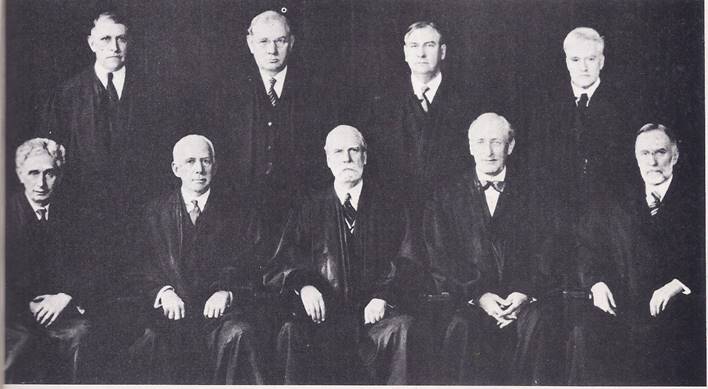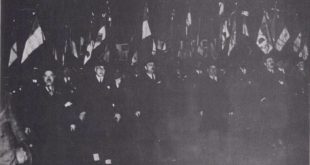BEGINNING his second term, Roosevelt made it plain that the New Deal would go on. He would continue to work for reforms. He said in his second inaugural address:
“In this nation I see tens of millions of its citizens — a substantial part of its whole population — who at this very moment are denied the greater part of what the very lowest standards of today call the necessities of life.
“I see millions of families trying to live on incomes so meagre that the pall of family disaster hangs over them.
“I see millions whose daily lives in city and on farm continue under conditions labelled indecent by so-called polite society of half a century ago.
“I See millions denied education, recreation and the opportunity to better their lot and that of their children.
“I see millions lacking the means to buy the products of farm and factory and by their poverty denying work and productiveness to many other millions.
“I see one-third of a nation ill-housed, ill-clad, ill-nourished. . . .
“It is not in despair that I paint for you that picture. I paint it for you in hope, because the nation, seeing and understanding the injustice in it, proposes to paint it out. We are determined to make every American citizen the subject of this country’s interest and concern and we will never regard any faithful law-abiding group within our borders as superfluous. The test of our progress is not whether we add more to the abundance of those who have much, it is whether we provide enough for those who have too little. . . .”
DEFEAT IN THE SENATE
To put through new reforms, Roosevelt felt that something had to be done about the Supreme Court. It had already blocked the NRA and other important New Deal legislation; he was determined not to let that happen again. He cast about for a way to reform the Court and on February 5, 1937, he announced his plan. Only a few men in his administration had known about it and the announcement was a complete surprise. The plan called for appointing a new judge for every Judge who had reached the age of seventy and had not retired. Although the Plan was to affect all Federal courts, there could be no doubt that Roosevelt had the Supreme Court in mind. Six of the Court’s judges were at least seventy years old. If Roosevelt’s plan became law, he would be able to appoint six new judges. The Supreme Court would no longer be made up of “nine old men,” as they had been called. Instead, there would be fifteen judges. Six of them would be new, younger men who would see the law in a different way.

Roosevelt’s plan was a shock, even to many of his supporters. They agreed that something had to be done about the Court, but they felt that Roosevelt was going about it in an underhanded way. Roosevelt’s opponents charged that the plan was an attempt to “pack the Court,” and a battle began in Congress. Democratic party leaders were having a hard time lining up votes for the bill and public opinion seemed to be against it. Nevertheless, Roosevelt insisted that the bill be passed, and the fight went on. When it came to a vote in the Senate, on July 22, it was defeated, 70 to 20.
Meanwhile, something unexpected had happened. The Supreme Court had suddenly begun to approve New Deal legislation. It upheld a number of laws, including the National Labour Relations Act and the Social Security Act. Then Justice Van Devanter, one of the “nine old men,” resigned. In August, Roosevelt appointed Senator Hugo L. Black of Alabama to take Van Devanter’s place — and again he ran into trouble.
As a senator, Black had been a strong supporter of the New Deal and had been known as a liberal. Now a newspaper reporter dug up proof that once, many years ago, Black had been a member of the Ku Klux Klan. In a radio broadcast, Black admitted that he had been a member of the Klan, but had resigned and never rejoined. He said that he had “no sympathy whatever with any organization or group which, anywhere or at any time, arrogates to itself the un-American power to interfere in the slightest degree with complete religious freedom.” The Senate approved his appointment and Black became one of the most liberal judges of the Supreme Court. During the next few years, two more judges resigned and one died. Roosevelt appointed three new men in their place and never again did he have trouble with the Court. He had lost the battle, but he had won his point.
As it turned out, Roosevelt had lost something more than the battle over the Court. The fight had weakened the Democratic party and his hold on it. The greatest days of the New Deal were coming to an end. Even so, Congress passed several important New Deal bills. Among them was the Wagner-Steagal Housing Act. This set up the United States Housing Authority, which could lend money to cities and states to clear slums and build low-cost housing. Another important bill was the Fair Labour Standards Act, which became law in 1938. It established a minimum wage and a maximum work-week for employees of firms that did business in more than one state. Within three years, the minimum wage was to be raised to forty cents an hour and the work-week lowered to forty hours. Workers were to be paid time-and-a-half for overtime. Children under sixteen years of age could not be employed and anyone under eighteen could not be employed at dangerous work.
In 1939, Roosevelt himself said, “We have now passed the period of internal conflict in the launching of our program of social reform. Our full energies may now be released to invigorate the processes of recovery in order to preserve our reforms.”
“WAR IS A CONTAGION”
Looking back over the past few years, Americans tried to judge the accomplishments of the New Deal. Roosevelt’s first administration, especially the dramatic first hundred days, had been a time of emergency and recovery measures. Then had come a period of reforms. The New Deal had cost a great deal of money and it had not really pulled America out of the depression. Millions of people were still out of work, but when Roosevelt had taken office, the country had been close to collapse. Somehow he had kept the economy going and had brought help and hope to the people. Laws had been passed that would have an effect for years to come. Never again would it be possible to say that the government had no responsibility for the welfare of the people. Most important of all, the United States had not gone either fascist or communist. In an age when totalitarianism was spreading, the nation had remained a democracy.
That democracy now faced another danger. As early as 1937, Roosevelt had said, “The peace, the freedom and the security of ninety per cent of the population of the world is being jeopardized by the remaining ten per cent. It seems to be unfortunately true that the epidemic of world lawlessness is spreading. When an epidemic of physical disease starts to spread, the community approves and joins in a quarantine. . . War is a contagion, whether it is declared or undeclared. . . We are determined to keep out of war, yet we cannot insure ourselves against the disastrous effects of war and the dangers of involvement.”
Before long, what happened in America would be determined by what happened in distant lands, in Europe and in Asia.





